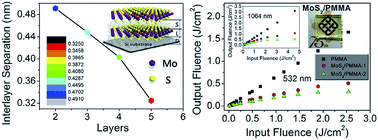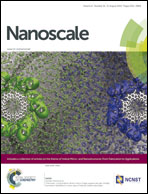Preparation and characterization of few-layer MoS2 nanosheets and their good nonlinear optical responses in the PMMA matrix
Abstract
Due to the relatively weak van der Waals (VDW) force between interlayers, few-layer MoS2 nanosheets are prepared using a simple ultrasonic exfoliation method and incorporated into PMMA. The good nonlinear optical (NLO) property of the MoS2/PMMA composite for the nanosecond pulsed laser at both 532 and 1064 nm has been first reported. The size, thickness and atomic structure of MoS2 nanosheets have been characterized by transmission electron microscopy (TEM) and atomic force microscopy (AFM). The interesting dependence of interlayer separation with respect to the layer number of MoS2 has been successfully quantified. The average interlayer separation of the MoS2 nanosheets increases and deviates much from the theoretical value with reducing the layer number. Such few-layer MoS2 nanosheets have been homogeneously incorporated into solid-state PMMA, which shows low optical limiting thresholds, 0.4 and 1.3 J cm−2, and low limiting differential transmittance (TC), 2% and 3% for the nanosecond laser operating at 532 nm and 1064 nm, respectively. The results suggest that MoS2 nanosheet incorporated PMMA is a promising candidate of the solid NLO material for optical limiting applications.


 Please wait while we load your content...
Please wait while we load your content...